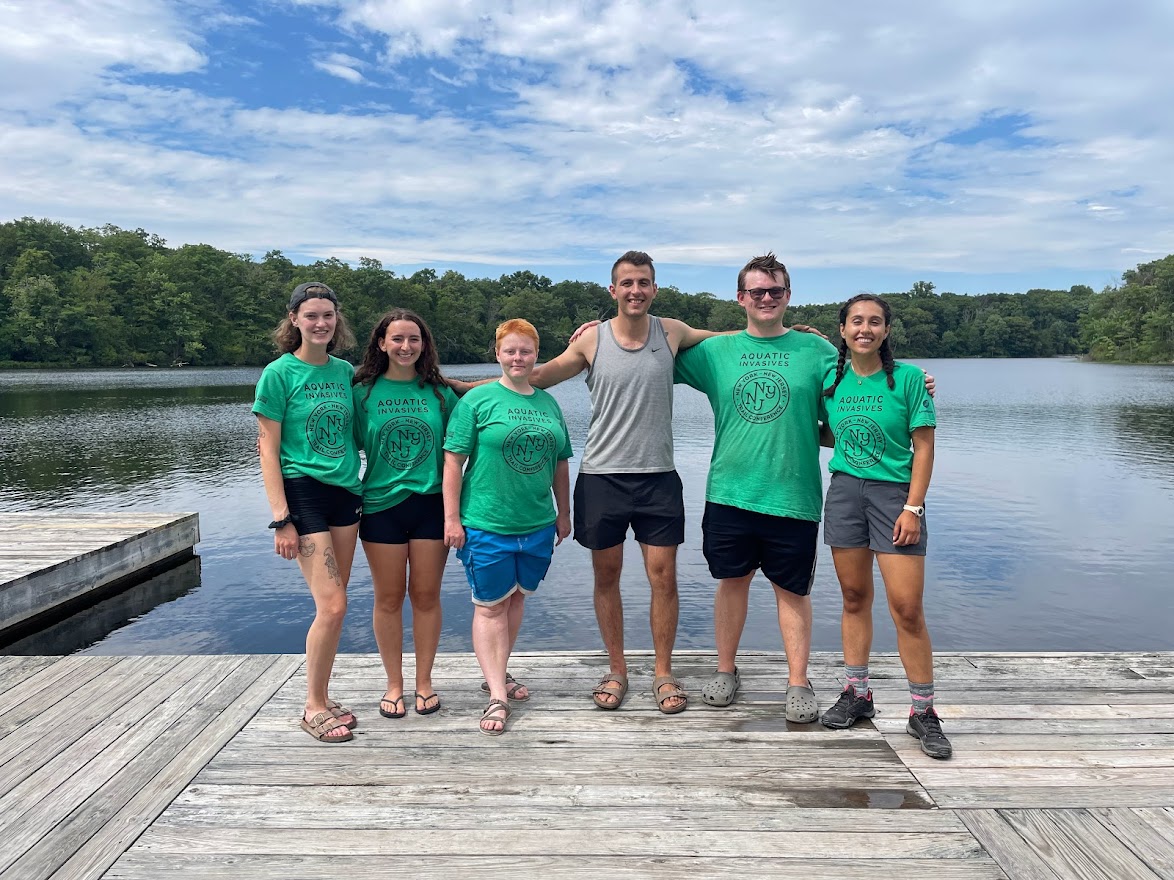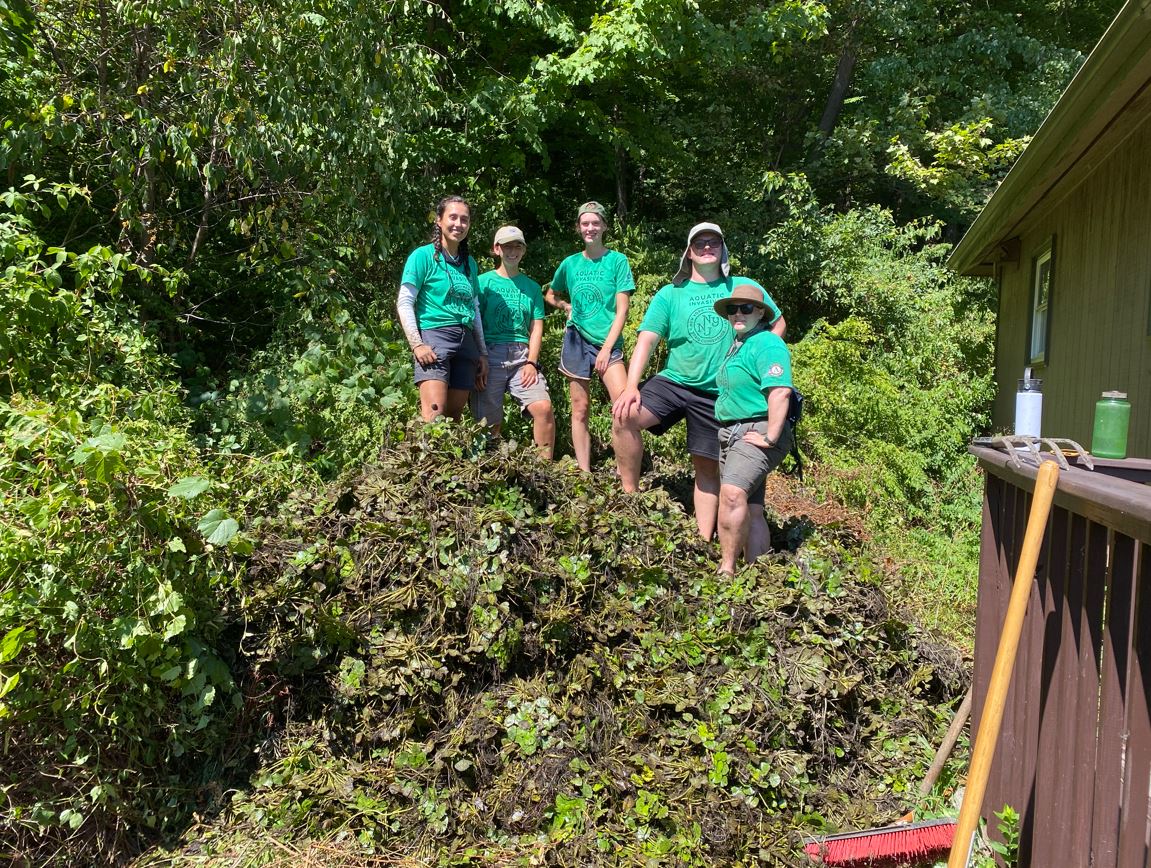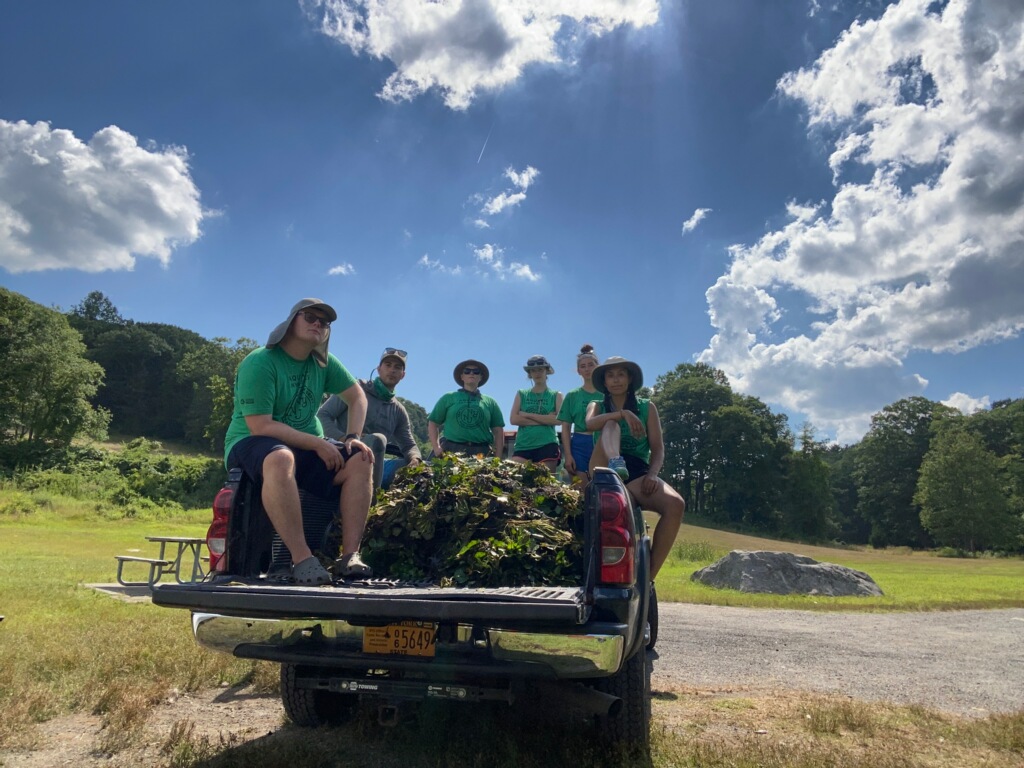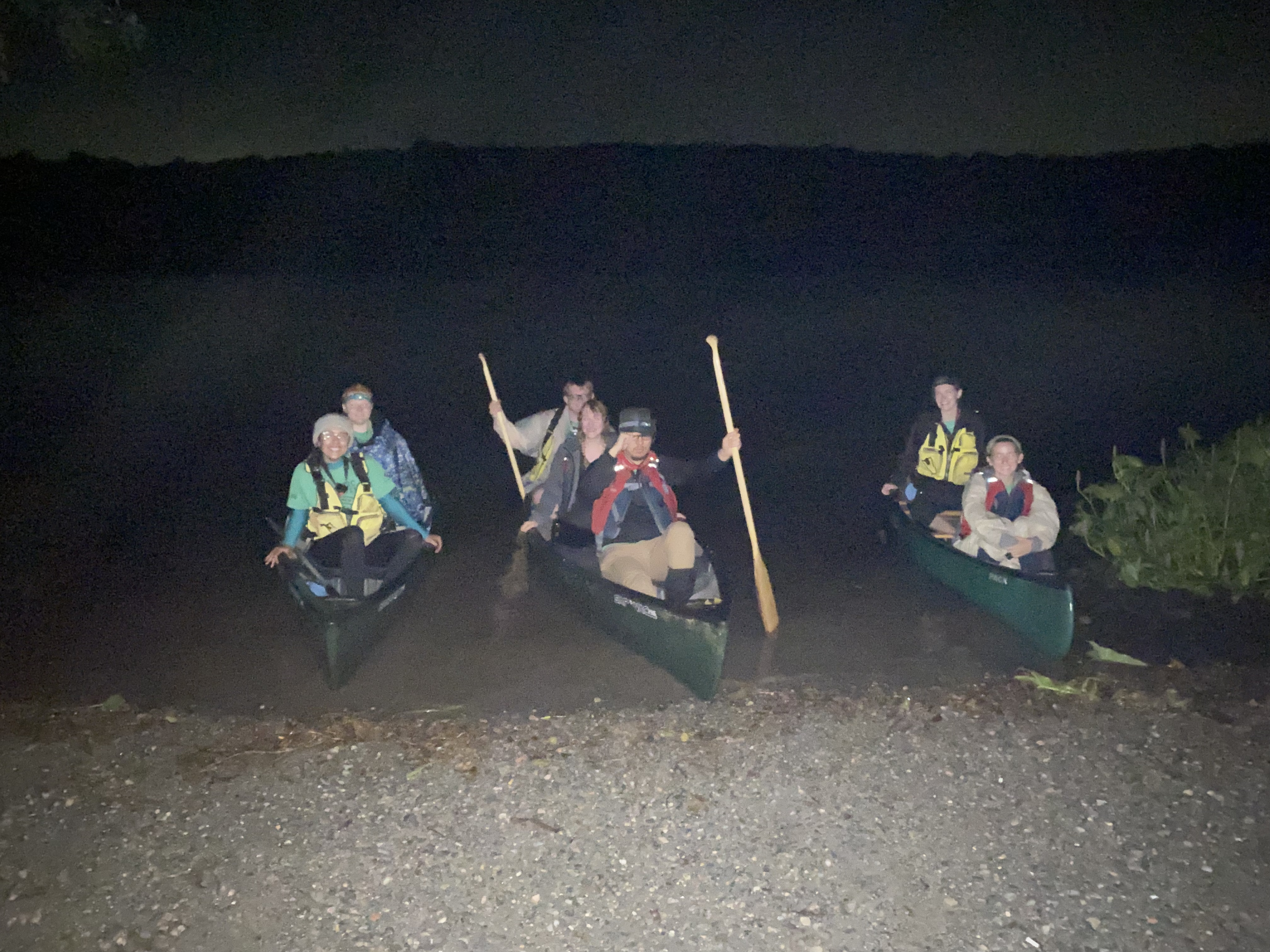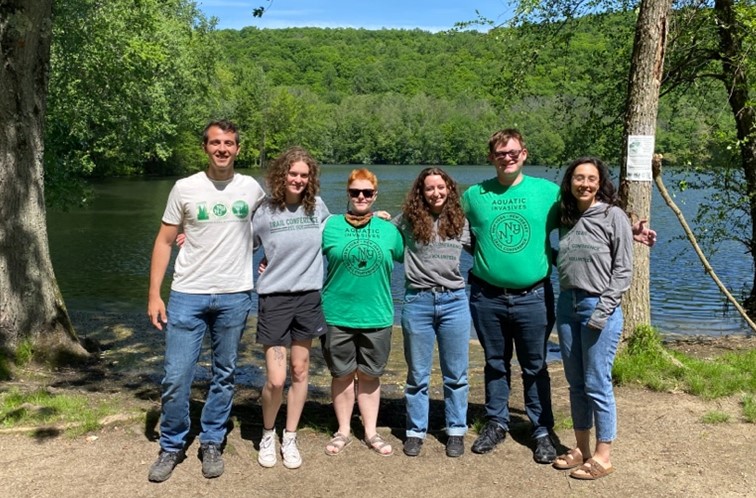The Aquatic Invasives Strike Force (AISF), a Trail Conference Conservation Corps crew funded through the Lower Hudson PRISM, is committed to preventing the spread of aquatic invasive species through education and outreach to active users of New York’s waterways while supporting management efforts through early detection surveys and manual removal of target species.
The AISF crew is managed, in part, by the LHPRISM Aquatic Invasive Species Program, hosted by Teatown Lake Reservation. All posts are written by Caleigh Millette, Aquatic Invasive Strike Force Crew Leader.
Table of Contents
End of the Aquatic Invasive Strike Force Season
The Aquatic Invasive Strike Force (AISF) Crew officially wrapped up our field season and has been focused on reporting during the last month of the Conservation Corps program. We had a few more chances to get out in the field before dedicating our time to summarizing and processing all the data we collected over the season. October began with one final survey of Canopus Lake in Clarence Fahnestock State Park, where several employees of NYS Office of Parks, Recreation & Historic Preservation joined us on rowboats! Gearing up in waders, we also went beach seining for the invasive round goby on the shore of the Hudson River. First observed in the Great Lakes Basin in the 90s, this bottom-dwelling fish is making its way down the Hudson. Luckily, we did not find any during our search at Croton Point Park! Seining is a fishing technique in which a large net is walked into the water and pulled back onto shore, surrounding fish and other critters that are then caught in the net.
Once all surveys were completed and data entered, we finally got the chance to review the data and begin creating reports for our stakeholders. In these reports, we compile a comprehensive list of aquatic species found, information on our processes, several graphs and vegetation maps, and a section that includes best management practices. We have separate reports for our water chestnut management sites, which includes acres managed as well as the total amount of pounds and rosettes pulled. Both report types use the data we collected and present it to our LH PRISM partners so they can make informed management decisions for their waterbodies.
As the season comes to an end, let’s look at the crew’s accomplishments over the year! We have surveyed 6,197 acres across 25 different waterbodies and recorded 2,755 observations of presence and density of native and invasive plants! Over the management season, we pulled a total of 74,000 water chestnut rosettes weighing in at 12,464 pounds. In our efforts to educate the public on the importance of cleaning watercrafts between uses, the crew has inspected 1,634 boats and reached 2,554 boaters during the Watercraft Inspection Steward Program. Our crew discovered the first occurrence of invasive hydrilla in Harriman State Park and worked with the NYS Department of Environmental Conservation to further map the infestation so they could create a management plan.
We are proud to have achieved such accomplishments and had a productive season of protecting and preserving the aquatic beauty of the Lower Hudson Valley! We would also like to thank everyone involved with making this season possible: our partners in the Lower Hudson Partnership for Regional Invasive Species Management (PRISM), staff at the New York-New Jersey Trail Conference, the Trail Conference Conservation Corps, and our program coordinator Devin DiGiacopo!
Finishing Up the Survey Season
Over the past month, the Aquatic Invasive Strike Force Crew worked on their second round of submerged aquatic vegetation surveys! We monitored nearly 2,000 acres and submitted 800 observations of absence, abundance, and density of native and invasive plants just this month. Throughout our most recent surveys, we noticed a varying abundance of certain plants that have different growth periods throughout the growing season. In particular, invasive curly leaf pondweed (Potamogeton crispus) typically grows in early spring, then begins to breakdown and disappear in midsummer. We’ve seen this to be true at Lake Shenorock in Westchester County! When we surveyed this lake in June, curly leaf pondweed dominated the small waterbody and by the time our second survey came around in early September, the infestation was reduced to decaying plant matter.
While doing a routine survey at Lake Sebago in Harriman State Park, the crew discovered the first occurrence of hydrilla, which has not been reported in Harriman State Park yet. Hydrilla (Hydrilla verticillata) is an aquatic invasive plant that is notorious for quickly growing dense mats that impede recreation and outcompete native plant species. Luckily, the crew caught this infestation as early as possible and reported it to the NYS Department of Environmental Conservation and the NYS Office of Parks, Recreation, and Historical Preservation, where proper management will be determined. Although aquatic invasive species can be transported by attaching onto waterfowl and other animals, it primarily spreads by hitchhiking on watercraft and aquarium dumping. For this reason, it is more important than ever to clean, drain, and dry watercrafts and all fishing equipment and properly dispose of aquarium plants and animals.
Furthering our professional development opportunities, the Aquatics crew assisted once again with NYS DEC and US F&WS on their northern snakehead eDNA rapid response effort in the Basha Kill Wildlife Management Area. This time, we collected water samples farther up the marsh to get a clear picture of how far this invasive fish has made it up the management area. All water samples collected were then filtered onsite and will be processed for eDNA detection.
Additionally, we participated in the Iona Island BioBlitz with the NYS Biodiversity Research Institute! We spent the day searching for different plants, fungi, animals, insects, etc. to identify and record around the island and in the surrounding marsh. The Aquatics crew contributed to the overall count of 260 species identified and 430 observations recorded in one day! We enjoyed the experience of curiously pausing to determine what plants are around us while exploring the island. Looking ahead to October, the crew will be wrapping up the last of their surveys and will begin data analysis and reporting!
Wrapping Up Water Chestnut Pulls & Continuing Surveys
August was a productive and fast paced month for the Aquatic Invasive Strike Force Crew! During the beginning of the month, we finished up the last of our water chestnut pulls. We visited four sites and manually removed 39,700 water chestnut rosettes, accumulating to 8,200 pounds of biomass. Three of the four sites managed during August were suppression sites, so we aimed to clear an area to support the population of native water celery (Vallisneria americana) and for an educational beach seining program. Our crew was able to collaborate once again with DEC Wildlife Technician Callie Barth-Dwyer at a lake in Orange County to continue the eradication of water chestnut in the endangered northern cricket frog’s breeding grounds. With her help checking each plant for frog eggs, we were able to pull 630 rosettes safely!
The crew also began the second round of surveys for the season! During this time, we return to all the lakes surveyed in the first monitoring season (May-June) to collect a new set of data. Because certain aquatic vegetation has different growth periods, it is important that we visit these sites twice a season to observe any species we may have missed earlier in the season. This far into the season, the crew has become quite efficient with the process of surveying and has even added some new native plants to our inventory! In our efforts, we have surveyed 876 acres across 9 lakes, and have recorded 455 observations of presence, absence, and density of native and invasive plants and animals.
We were able to return to the Croton River with Nicole White, the Croton Hydrilla Control Project Manager with the DEC! The crew snorkeled the chilly river again to do another check for more invasive hydrilla (Hydrilla verticillata) and found no plants this time. This points to the success of the Croton Hydrilla 5-year Management plan!
As the water chestnut pulling season has come to an end, we would like to thank everyone involved in this endeavor: Westchester Parks Foundation, Three Arrows Cooperative Society, Constitution Marsh Audubon Center, Black Creek Preserve – Scenic Hudson, and the NYS DEC! Looking forward to September, the crew will be finishing up their surveys and continuing the search for invasive and native plants before fall sets in.
The AISF Crew standing successfully on their pile of water chestnut at Constitution Marsh. Left to right: Christina Arroyo, Catherine Farrell, Caleigh Millette, Logan Collier, Red Goering
The AISF Crew looking into the water, ready for hydrilla hunting via snorkel. Image includes the crew along with Nicole White, Linsday Charlop, and Devin DiGiacopo
Invasive Species Management Season Progress –– Pulling and Snorkeling
July marks the beginning of a new chapter in the Aquatic crew’s field season –– the removal of water chestnut! Water chestnut nutlets grow to maturation by July and then drop off towards the end of August, so it is crucial that the plant itself is removed during this time frame to help prevent new growth the following year. In the month of July, the crew has manually removed 34,228 water chestnut rosettes from 8 different sites, which accumulates to 4,240 pounds of biomass! There are specific goals for each site we visit depending on parameters such as infestation size and density. Eradication of water chestnut at a site is possible when the infestation is smaller than five acres and trace to sparse in density, and removal is consistent for several years. Overall, we aim to suppress moderate to dense infestations that are larger than five acres. For these suppression sites, the goal usually is to clear an area for recreation or education. We also had the Terrestrial ISF crew help us out at Rockland Lake, where both crews removed almost 4,000 rosettes (1,200 pounds) from a boat launch area!
The Aquatic crew had an amazing opportunity to work with Nicole White, the Croton Hydrilla Control Project Manager with the DEC. We performed a snorkeling survey of part of the Croton River in search for hydrilla and only found one small hydrilla plant! The Croton Hydrilla 5-year Management plan was put into place in 2018 by the NYS DEC to prevent a large infestation of hydrilla in the Croton River from entering the Hudson River. The one plant found by the crew was bleached and stunted, indicating the plan’s success on spread prevention and infestation control.
At Lake Carmel in Putnam County, the crew worked on removing a somewhat new infestation of water chestnut and broke out their snorkels again for another invasive removal! This time, the crew dove to search and hand-pull 600 Eurasian watermilfoil plants from one area of this large lake.
We also performed two pre-treatment surveys (and three routine surveys) to assess the invasive infestation and the native vegetation before pulling water chestnut. During the five surveys completed, we monitored 1,126 acres and recorded 345 observations of presence and density of native and invasive aquatic vegetation. The crew has a few more water chestnut pulls to accomplish before we begin our second monitoring season, where we will be returning to all the sites from late spring/early summer to see how the vegetation has changed.
The AISF Crew posing with their pile of water chestnut at Silver Mine Lake in Harriman State Park.
Left to right: Logan Collier, Devin DiGiacopo, Red Goering, Caleigh Millette, Catherine Farrell, Christina Arroyo
2022 Monitoring Season Progress and Professional Development Opportunities
With the field season well underway, the Aquatic Invasive Strike Force Crew has already made great progress with surveying waterbodies and inspecting watercraft for aquatic hitchhikers! In the month of June, we have surveyed 1,286 acres across 10 lakes, and have recorded 601 observations of presence, absence, and density of native and invasive plants and animals. At the end of June, we transition from monitoring lakes to managing invasive water chestnut for the month of July. The crew will then return to our monitoring sites once the management season is complete to see how the vegetation fluctuates into late summer.
We have also had some wonderful opportunities to work with state agencies on ongoing research projects! The AISF Crew teamed up with NY State Department of Environmental Conservation and NY Fish & Wildlife Service to assist with the northern snakehead rapid response effort in the Lower Hudson Region. We helped collect water samples along the Basha Kill Marsh, which were then used in environmental DNA (eDNA) testing by using a vacuum filtration system. This can detect if any DNA particles are present in a waterbody, as well as identify the organism even when the eDNA is in low abundances!
With assistance from DEC Wildlife Technician Callie Barth-Dwyer, the AISF Crew searched for water chestnut to possibly remove at a lake in Orange County, so long as no endangered northern cricket frogs were present in those areas. This frog mainly uses floating aquatic vegetation as its habitat and breeding ground. A frog call survey was also performed late at night, where the following calls were heard: green frogs, gray tree frogs, bullfrogs, and of course northern cricket frogs.
Overall, the crew had a busy month understanding the native and invasive plants across the Lower Hudson Valley and enjoying the unique opportunities to work with NYS government agencies on their research projects. We are looking forward to a packed month of managing water chestnut. Stay tuned to hear what the AISF Crew accomplishes!
May
Kicking off the 2022 Conservation Corps Season!
April and May have been jam packed with planning and training the new Aquatic Invasives Strike Force Crew for a full summer of monitoring and managing aquatic invasive species! April was spent using online models to search for lakes within the Lower Hudson PRISM that are highly vulnerable to an aquatic invasion, as well as scheduling and prepping for the busy season. So far in May, the crew has surveyed 463 acres across 8 lakes, and has recorded 366 observations of presence, absence, and density of native and invasive plants and animals. In our efforts, we have found somewhat common – but invasive – plants and animals such as Eurasian watermilfoil, variable-leaf watermilfoil, fanwort, and Chinese mystery snails in several lakes across Harriman State Park.
We also began the Watercraft Inspection Steward Program, or WISP, during Memorial Day Weekend! This program gives the crew a chance to educate the public on the importance of stopping the spread of invasive species and catch any hitchhiking invasive plants simultaneously. This program will continue through September. Stay tuned to hear about some exciting projects the crew will be working on soon!
We would also like to thank Loren Edelson and Jeremy Katz from the American Canoe Association for training the AISF Crew on canoeing!
The 2022 AISF Crew, from left to right: Devin DiGiacopo (Program Coordinator), Caleigh Millette (Crew Leader), and Crew members Red Goering, Catherine Farrell, Logan Collier, Christina Arroyo.

